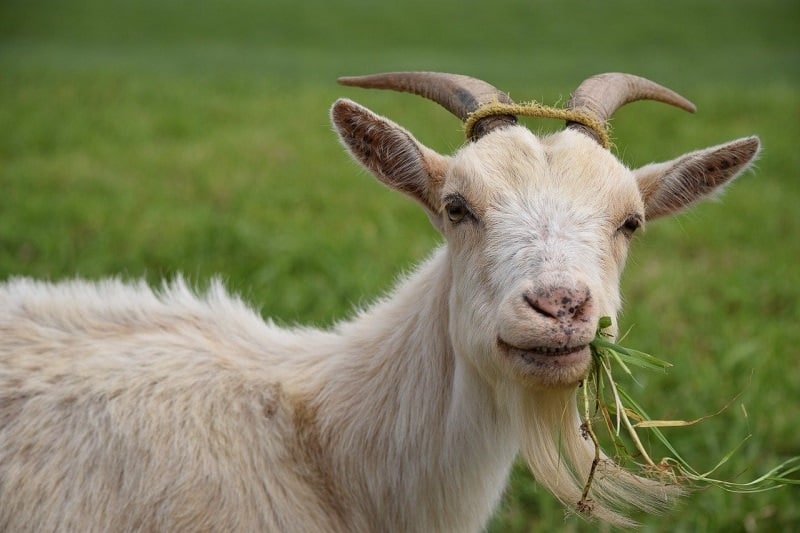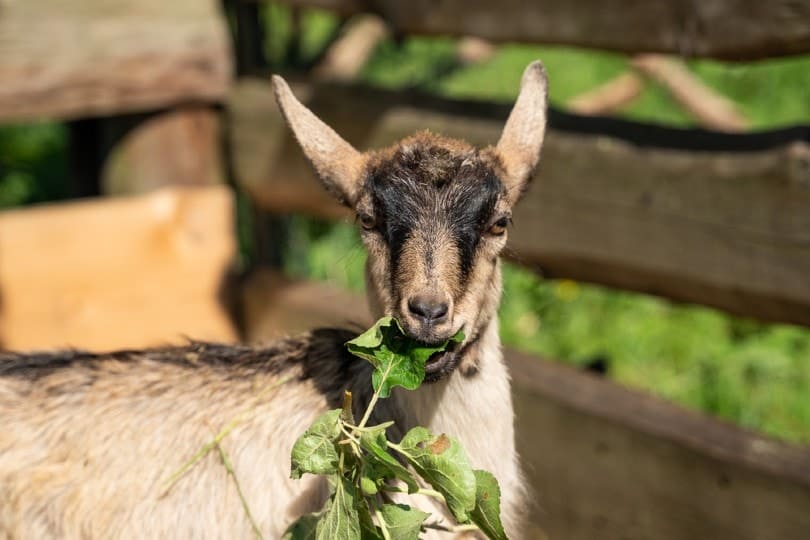This might sound like a silly question on the surface. After all, of course goats have top teeth, right? The answer to this question about goat dentition is a little more surprising and complex than a simple “yes” or “no”. If you’ve spent time around goats, you may have noticed that they don’t appear to have top teeth, but then how would they chew and eat their food? The truth is, that goats only have upper molars. Here’s what you need to know about whether goats have top teeth.

Do Goats Have Top Teeth?
Yes…and no! Goats have a full set of bottom teeth. On the top, they only have molars, which are the large, flat teeth toward the back of the jaw. Goats lack the upper front teeth that most other mammals have. However, goats are ruminants, and ruminants lack canine teeth, which are the sharp teeth you see toward the front of the mouth in many mammals.
Other ruminants include cattle, water buffalo, giraffes, elk, deer, sheep, and camels. In place of those front upper teeth, goats have a dental pad. A dental pad is a pad of thickened tissue that serves as the partner to the bite of the lower teeth. This dental pad allows goats to grab and tear their food in conjunction with the lower incisors, or front teeth.

How Do Goats Chew Their Food?
The dental pad and bottom incisors work together to tear at food, but how can goats chew their food without those upper teeth? Well, goats don’t chew their food in the front of their mouth. Like humans, they use their tongue to move food to the back portion of the mouth where the molars take over. Molars are large and flat, which makes them ideal for macerating food until it is thoroughly chewed and ready to be swallowed.
Goats have a four-chambered stomach since they are ruminants. This means that when they first consume food, it goes into the first stomach portion, or the rumen. Food spends a lot of time in the rumen, which uses bacteria to ferment the food the goat has consumed. Once at rest, the goat will regurgitate the food back into the mouth and chew it again. This is an important digestive step for ruminants to ensure proper, healthy digestion.
The use of the rumen means that goats don’t have to completely break down food in the mouth before swallowing it since it will begin digesting before coming back for a second round of chewing. Although a goat’s molars are effective at macerating their food, the second round of chewing ensures the food is properly macerated to go through the rest of the four-chambered digestive process.

Why Don’t Goats Have Top Teeth?
Goats have evolved to lack top front teeth because they proved to be an unnecessary part of their digestive process. The dental pad functions effectively at assisting goats with tearing food, and then the tongue successfully moves the food to the molars where it is then macerated prior to a visit to the rumen. Also, don’t let their lack of front upper teeth fool you. Goats have a total of 32 teeth, which is the same number of teeth as an adult human if you count all four wisdom teeth.

In Conclusion
Did this answer surprise you? On the surface, it does seem like a silly question, but it’s a question that has a fascinating answer. Goats lack upper front teeth because they are unnecessary to their digestive process. They do have upper molars, though, which allows them to crush and gnaw their food until it is ready to be swallowed and transferred to the rumen, which then sends the food back to the mouth as cud for further chewing. The digestive process of ruminants is a fascinating one and is very different from what humans do. Our single-chambered stomachs can perform all digestive processes, and then nutrients continue to be absorbed from our food as it continues through the digestive tract.
Featured Image Credit: David Kay, Shutterstock
